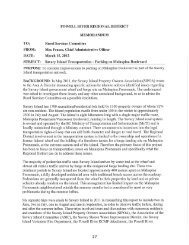SIVFD NEWS - savary island committee
SIVFD NEWS - savary island committee
SIVFD NEWS - savary island committee
Create successful ePaper yourself
Turn your PDF publications into a flip-book with our unique Google optimized e-Paper software.
<strong>SIVFD</strong> <strong>NEWS</strong><br />
2009 SUMMER EDITION<br />
ISSUE 2 PAGE 2 SUMMER 2009<br />
Before<br />
After<br />
An example of a high-risk fuel cleanup in Whistler.<br />
and could threaten the entire <strong>island</strong>. Many popular camping<br />
spots on Savary beaches are adjacent to highly flammable<br />
fuels such as driftwood, dry grass, scotch broom,<br />
dead trees, and fallen branches.<br />
What can we do?<br />
SAVARY ISLAND<br />
CWPP<br />
“<br />
100%<br />
of fires with<br />
known causes<br />
were the<br />
result of human<br />
ignition.”<br />
You can start with spending a day,<br />
or a weekend cleaning up your<br />
property of anything that looks<br />
like kindling. Think about the path<br />
a fire would take if it were started<br />
by a spark or ember. Remove fallen<br />
branches, low branches (as<br />
high as you can reach), dried long<br />
grass, dead trees, scotch broom (unless it’s stabilizing a<br />
slope), and dry or dead plants. As well as reducing the<br />
risk of fire you will be surprised at how good everything<br />
looks afterwards. Allowing more light onto the forest<br />
floor will encourage green plants to thrive, which then<br />
act as a fire break by making fire more difficult to spread.<br />
The <strong>SIVFD</strong> will be requesting that the Ministry of<br />
Transportation (MoT) clean up the roadsides so that wood<br />
waste accumulations do not contribute to the fire risk<br />
across Savary.<br />
If you are having a campfire (when it is allowed) make<br />
sure you keep it under 2 feet in diameter, have water or<br />
a shovel close by, keep it 10 ft from grass and combustibles,<br />
and never leave it unattended.<br />
Let’s all do our part to reduce the risk of wildfire. ■<br />
Structure Protection<br />
Your cabin’s vulnerability to fire.<br />
Sparks, embers, and firebrands.<br />
We’ve all seen small sparks and embers coming from a<br />
fireplace or backyard burn, but not many of us have seen<br />
a firebrand. This is a large piece of burning wood that<br />
has been lifted high into the air by the heat of a forest<br />
fire or house fire. Firebrands are the largest cause of<br />
secondary fires starting hundreds of feet away, sometimes<br />
even miles away from<br />
the original fire. In 2005, the<br />
cabin fire on Tennyson caused<br />
firebrands to be thrown hundreds<br />
of feet into the air and<br />
were found half a block away<br />
(500 feet). To demonstrate the<br />
hazard, the fire chief brought<br />
these baseball-sized firebrands<br />
to the next fire practice. It<br />
showed us that while we are<br />
fighting the original fire, we<br />
An example of a<br />
firebrand on a roof.<br />
must be on the lookout for spot<br />
fires caused by firebrands. We<br />
are all fortunate that another cabin fire, or two, wasn’t<br />
started by firebrands landing in an eavestrough full of<br />
dry needles, a debris-covered roof or deck, or woody<br />
debris on the Savary forest floor.











